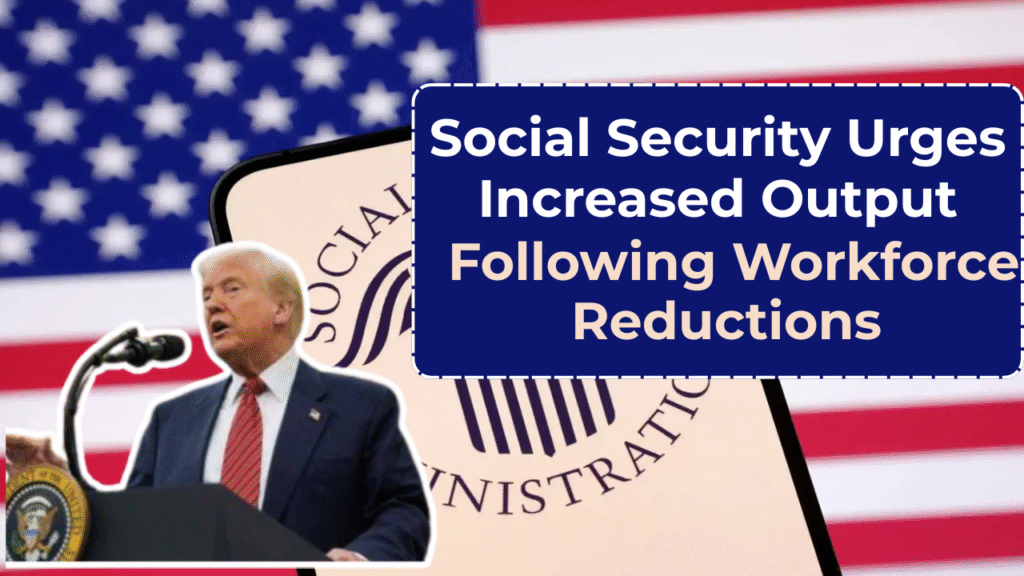Agency Faces Staffing Crisis After Workforce Cuts
In the wake of significant staffing reductions, the U.S. Social Security Administration (SSA) has called on its remaining workforce to increase productivity by at least 10% to maintain critical service levels. This directive comes as the agency struggles to manage rising workloads with a shrinking pool of employees.
The SSA, which administers retirement, disability, and supplemental income benefits to over 70 million Americans, has faced increasing scrutiny over growing delays and deteriorating customer service. With limited funding and a reduced headcount, officials say they are left with no choice but to ask more of those who remain.
Layoffs Spark Internal Alarm
Earlier this year, the SSA announced layoffs impacting thousands of employees, including workers at field offices, teleservice centers, and disability processing units. These cuts were the result of congressional budget decisions that left the agency underfunded for fiscal year 2024.
Though technically not labeled as “layoffs” in a traditional sense—since many of the reductions came via attrition, hiring freezes, and the expiration of temporary positions—the effect has been the same: fewer staff on the ground to assist the public.
In a memo sent to SSA employees, the agency’s leadership acknowledged the “difficult circumstances” but urged staff to find ways to be more efficient. “Given our current staffing levels, we are asking each employee to increase their output by 10% where feasible to help us meet the needs of the American people,” the memo read.
Mounting Workloads and Backlogs
The staffing crisis comes at a time when the demand for Social Security services is increasing. As Baby Boomers continue to retire in large numbers and disability claims rise, SSA field offices and phone lines are seeing a surge in activity.
According to recent data, the average wait time for a phone call to the SSA has risen to over 35 minutes, and field office appointments are being scheduled weeks—sometimes months—in advance. Disability hearings have also seen major backlogs, with claimants often waiting over a year for a decision.
An SSA spokesperson said the agency is working to streamline processes and leverage technology, but acknowledged that “human resources remain our most important asset.”
Employee Morale and Union Pushback
Not surprisingly, the call for increased productivity has drawn criticism from employee unions and advocacy groups. The American Federation of Government Employees (AFGE), which represents thousands of SSA workers, has pushed back on the directive, citing burnout, low morale, and unfair expectations.
“SSA employees are already overburdened and under-supported,” said AFGE Council 220 President Jessica LaPointe. “Telling workers to ‘do more with less’ isn’t a sustainable solution—it’s a recipe for further decline in service quality.”
Internal surveys have shown that SSA employees are reporting higher levels of stress and job dissatisfaction. Many fear that ongoing staffing cuts could lead to more errors, lower service standards, and a further erosion of public trust.
Funding Shortfalls and Congressional Action
Much of the SSA’s current predicament stems from budgetary limitations. Despite rising workloads, the agency has not received a commensurate increase in administrative funding. In fact, SSA’s operating budget has declined by about 17% in inflation-adjusted terms over the past decade, even as the number of beneficiaries has grown.
In March 2024, Congress approved a continuing resolution that provided limited additional funds to prevent furloughs, but it did not restore full staffing levels or reverse the cuts. Advocacy groups are now lobbying for a long-term funding increase in the fiscal year 2025 appropriations bill.
Representative John Larson (D-CT), a long-time proponent of Social Security reform, has called on lawmakers to boost SSA funding. “The American people deserve better. You can’t run a vital public service like Social Security on a shoestring budget,” Larson said in a statement.
Technology vs. Human Service
In response to the staffing challenges, SSA has increased its emphasis on digital services, encouraging beneficiaries to use the online portal for benefit estimates, status checks, and direct deposit management. While these tools have helped reduce some pressure on field offices, critics say they are not a substitute for human interaction—especially for older adults and people with disabilities.
A recent inspector general report warned that SSA’s shift to digital-first services risks leaving behind the most vulnerable claimants. The report emphasized the importance of in-person and telephone support, particularly for those who struggle with online systems.
The Road Ahead
As the SSA navigates its post-layoff reality, the agency faces a difficult balancing act: improving efficiency without sacrificing service quality or burning out its workforce. While a 10% productivity increase may be a short-term goal, many believe the long-term solution lies in restoring full staffing and investing in modernization.
For now, employees will continue doing more with less, answering phones, processing claims, and supporting millions of Americans who depend on the agency every day.
As one SSA employee told us anonymously, “We care deeply about our work. But there’s only so much you can do when half your team is gone.”




